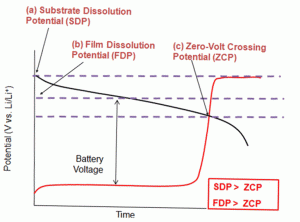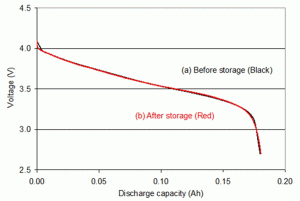Alex Fay, Business Development Manager
Quallion LLC
Recent battery fires in electric vehicles have prompted automakers to recommend discharging lithium ion batteries following serious crashes. However, completely discharging a vehicle’s battery to ensure safety will permanently damage the battery and render it worthless. Self-discharge effects and the parasitic load of battery management system electronics can also irreversibly drain a battery.
Technologies developed for medical and satellite applications may hold the key to improving safety in electric vehicles without sacrificing the batteries.
Lithium ion batteries generally experience significant reduction in capacity following a deep discharge as the substrate and film of the solid electrolyte interface (SEI) dissolves. As a result, lithium ion batteries require battery management systems (BMS) to prevent deep discharges, and batteries are never designed to be completely discharged. Because of the electrical energy they contain even at low state of charge (SOC), lithium ion batteries always present a hazard of fire or shock, and these risks are compounded in the high voltage systems used in electric vehicles.
Quallion’s patented Zero-Volt technology enables a lithium ion battery to be completely discharged to an inert state, stored in this condition for an extended period, and then recharged without any permanent damage to the battery or reduction in capacity or performance. Applied to electric vehicles, this technology can enhance the safety of first responders and auto technicians who risk electrocution from contact with an energized high voltage system, and it can reduce warranty costs of replacing batteries that are destroyed as a safety precaution. Zero-Volt also enables long term storage and shipping of vehicles with batteries in an inert state, eliminating the risk of fire or explosion that has caused fatalities and property damage when lithium ion batteries have combusted in cargo planes during shipment or in storage facilities following crashes.
The Difference Between Zero-Volt and Zero SOC
In normal parlance, a battery is dead when it reaches the lower limit of its operating voltage range. At this point, the battery has a SOC of zero. However, because the low end of the operating voltage of lithium ion batteries is designed to around 3 V, a battery with zero SOC still contains some latent energy. This energy is not enough to prove useful in an application, but it can be enough to cause a fire if the battery is damaged. In the high voltage systems used in electric vehicles, with many cells connected in series, this latent energy can be enough to deliver an electric shock that can fatally stop a human heart.
In contrast, Zero-Volt means that all of a battery’s stored energy has been discharged, well below the normal operating voltage range. At this point, a lithium ion cell is rendered totally inert. A cell or battery in a Zero-Volt condition poses no risk of fire, explosion or electric shock.
Quallion has demonstrated this technology and has produced thousands of Zero-Volt enabled lithium ion cells and batteries for medical and aerospace applications. In implantable medical devices, batteries can become totally discharged as a result of self-discharge, parasitic drain of electronics, and patient non-compliance with the recommended charging regimen. Using traditional lithium ion cells, this deep discharge would result in permanent damage to the battery and require replacement of the battery through surgery. However, a Zero-Volt enabled cell can simply be recharged and regain its full functionality, avoiding the unnecessary pain and expense of surgery and replacement components.
In satellite applications, Zero-Volt technology enables long term storage of inert batteries without maintenance charging or degradation. This storage period can amount to years between the procurement of batteries and the launch of a spacecraft. With Zero-Volt technology, the batteries can be charged just before launch, and the mission control team can be confident that the batteries will perform as if they were brand new, even under the rigorous cycling requirements of low earth orbit satellites.
How Zero Volt Works

Zero-Volt technology relies on manipulating individual electrode potentials within a lithium ion cell to allow deep discharge without inflicting damage to the cell. Quallion has identified three key potentials affecting the Zero-Volt performance of lithium ion batteries. First, the Zero Crossing Potential (ZCP) is the potential of the negative electrode when the battery voltage is zero. Second, the Substrate Dissolution Potential (SDP) is the potential at which the negative electrode substrate begins to corrode. Finally, the Film Dissolution Potential (FDP) is the potential at which the SEI begins to decompose. The crucial design parameter is to configure the negative electrode potential to reach the ZCP before reaching either the SDP or the FDP at the end of discharge. This design prevents damage to the negative electrode which would result in permanent capacity loss. Figure 1 shows a schematic of the voltage profile during deep discharge of Quallion’s Zero-Volt cells.

To enable Zero-Volt technology, Quallion uses selected active and non-active materials to manipulate potentials within the cell at the end of discharge. These materials were selected to meet energy and life requirements of the medical and satellite markets. Automotive applications will need materials to be selected by factoring in cost, power and energy requirements, cycle life and manufacturability. Quallion’s Zero-Volt design is not limited to a particular chemistry or set of materials, and it could be implemented in existing electric vehicle battery manufacturing using a few alternative approaches with minimal adjustments.
Implementing the Zero-Volt technology does not have a negative impact on cell performance, and testing has demonstrated comparable results for capacity and cycle life with conventional lithium ion designs. Figure 2 shows a comparison of discharge curves before and after 24 months of storage at deep discharge. The improved batteries have almost no capacity degradation after almost two years of storage. The improved deep

discharge design was also tested with a combination of deep discharge and cycling performance. Figure 3 shows a life test of 300 cycles performed at C/2 at 37°C before and after 24 month storage at deep discharge at 37°C. The deep discharge storage does not affect cycle life performance.
Zero Volt Applications in Electric Vehicles
Zero-Volt technology can help improve the safety and reduce the costs of plug-in hybrid and electric vehicles, helping accelerate their penetration into the market. In the event of a serious vehicle collision, a Zero-Volt enabled vehicle battery could be completely discharged and rendered safe when there was even the slightest concern that it may have been damaged. In 2011, a Chevrolet Volt caused significant damage when it caught fire weeks after government crash testing. The crash had damaged the battery’s cooling system, which lead to the fire. This incident prompted congressional hearings and a broad effort by General Motors to modify the batteries of existing vehicles1. Had the battery been completely discharged following the crash, there would have been no risk of fire.
Electric vehicle manufacturers have published recommendations to discharge batteries following accidents, and they have assembled rapid response teams poised to supervise battery discharge, storage and repair of electric vehicles following an accident. This approach may be practical while vehicles are in limited production in target markets, but increasing numbers of electric vehicles and greater geographic dispersion will quickly swamp these rapid response teams. In recognition of this problem, the Society of Automotive Engineers has convened a task force to develop an industry-wide recommended practice for dealing with electric vehicles following crashes. A consensus has emerged around post-crash battery discharge, but the industry has yet to address the implications of this policy: significant numbers of unnecessarily destroyed batteries requiring replacement.
Industry policies dictate that when there is some uncertainty about the degree of damage to a battery, it should be discharged as a prudent precaution. For batteries that have not been damaged, this policy will result in unnecessarily destroying otherwise healthy batteries. This poses a significant cost to electric vehicle owners, insurance companies and automakers providing warranties, especially given that the battery can cost about as much as the balance of the vehicle.
Zero-Volt technology can eliminate these unnecessary costs due to discharging undamaged batteries. If a Zero-Volt enabled battery is discharged completely as a precaution and further investigation shows no signs of damage, then the battery can simply be recharged and resume normal operation without incurring the cost of battery replacement.
Electric vehicles have also suffered from batteries being destroyed by deep discharges when they remain unplugged for extended periods of time. Recently some vocal Tesla roadster owners complained of batteries that “bricked” after weeks of storage due to the parasitic drain of the vehicle’s electronics, requiring a battery replacement costing $40,000 and not covered by the vehicle’s warranty. Whether attributed to an inattentive owner2, a faulty charge cord or some other cause, this is a very expensive problem which Zero-Volt technology can eliminate.
Furthermore, Zero-Volt technology can help reduce costs by streamlining logistics and transport of individual lithium ion cells and large lithium ion batteries. Zero-Volt cells and batteries can be stored and shipped in a totally discharged state and without special storage and handling requirements designed to ensure safety. Batteries can also be completely discharged when a vehicle requires service, thereby reducing costs of maintaining high voltage service facilities and eliminating the risk of electrocution to service personnel. These supply chain improvements can yield cost reductions that will help reduce the costs of electric vehicles.
Conclusion
Lithium ion batteries are critical to the near and mid-term success of the electric vehicle market, but they are inherently dangerous and pose serious safety risks. Zero-Volt technology developed for medical and satellite industries, which have zero tolerance for failure, can improve the safety of lithium ion batteries used in electric vehicles. This technology can help assuage public concerns about safety, leading to broader acceptance and increased consumer demand. Developing a mature electric vehicle industry requires overcoming the safety challenges inherent in high energy density batteries, and it’s worth a look at the lessons learned from a decade of experience in advanced medical and aerospace applications.
References
1. The Economist. Dec 08 2012. http://www.economist.com/
blogs/babbage/2011/12/battery-vehicles
2. The Understatement.com. Feb 21 2012.
http://theunderstatement.com/post/18030062041/its-a-brick-
tesla-motors-devastating-design
Alex Fay manages business development efforts targeted at clean transportation applications and oversees research and development programs at Quallion, a manufacturer of lithium ion batteries for medical, military, aerospace and
transportation applications.
For more information, please www.quallion.com.
This article was printed in the April/May 2012 issue of Battery Power magazine.







